Digital Technologies in E-Commerce: Development, Models and Management
VerifiedAdded on 2023/06/12
|11
|2636
|248
Report
AI Summary
This report provides a comprehensive overview of digital business and e-commerce, highlighting the importance of digital technologies in enhancing business performance. It explores the development of e-commerce through four distinct phases, emphasizing the role of technologies like AI, chatbots, and cloud computing. The report discusses various e-commerce platforms and software, including SaaS, PaaS, and on-premises solutions, and categorizes businesses using e-commerce into B2C, B2B, C2B, and C2C models. Furthermore, it examines the relationship between digital technologies and traditional and modern business management theories, focusing on how e-commerce models like B2C, B2B, C2B, and C2C have evolved with digital advancements. The report concludes that digital technology is crucial for business efficiency, cost reduction, and rapid growth in a competitive environment.
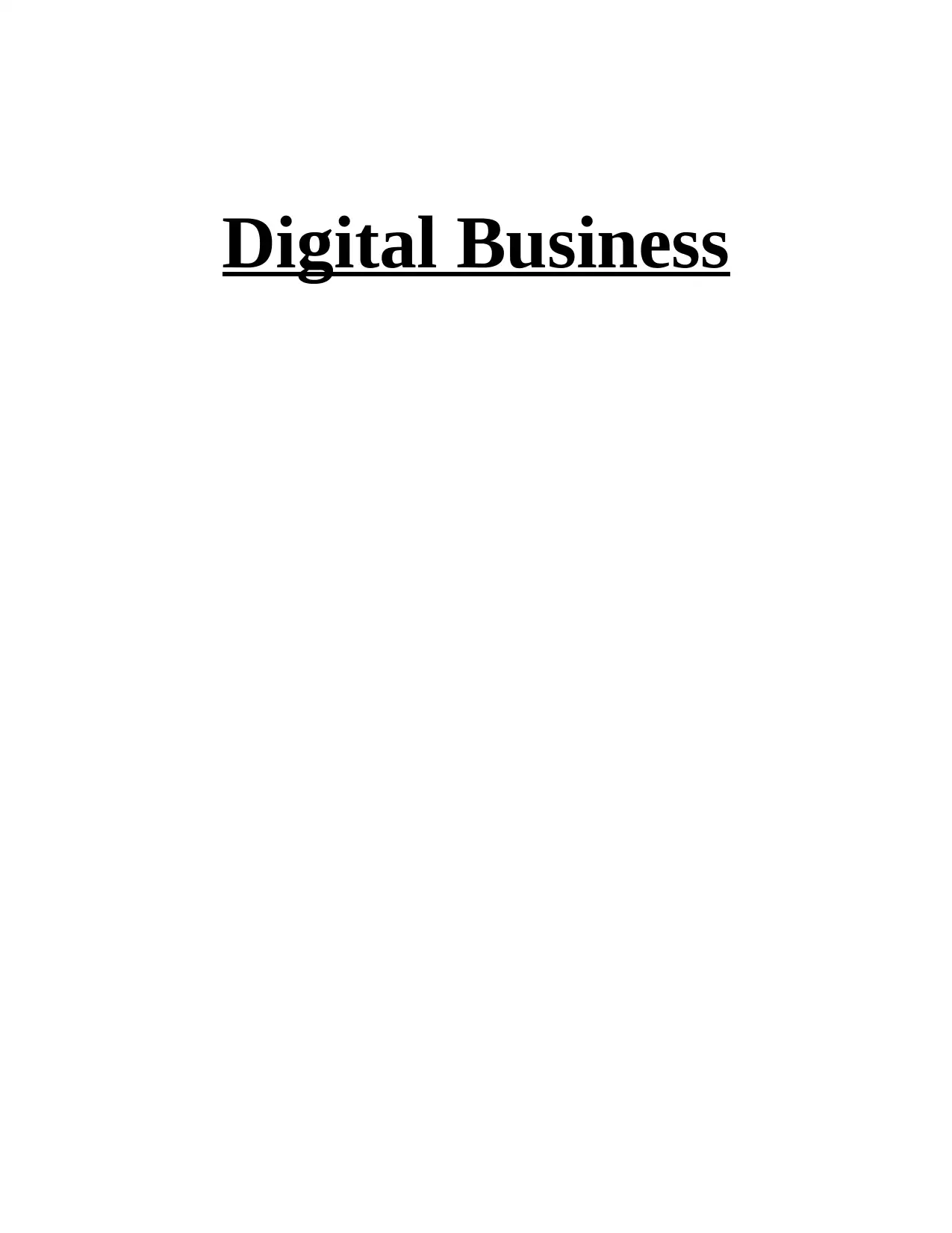
Digital Business
Paraphrase This Document
Need a fresh take? Get an instant paraphrase of this document with our AI Paraphraser
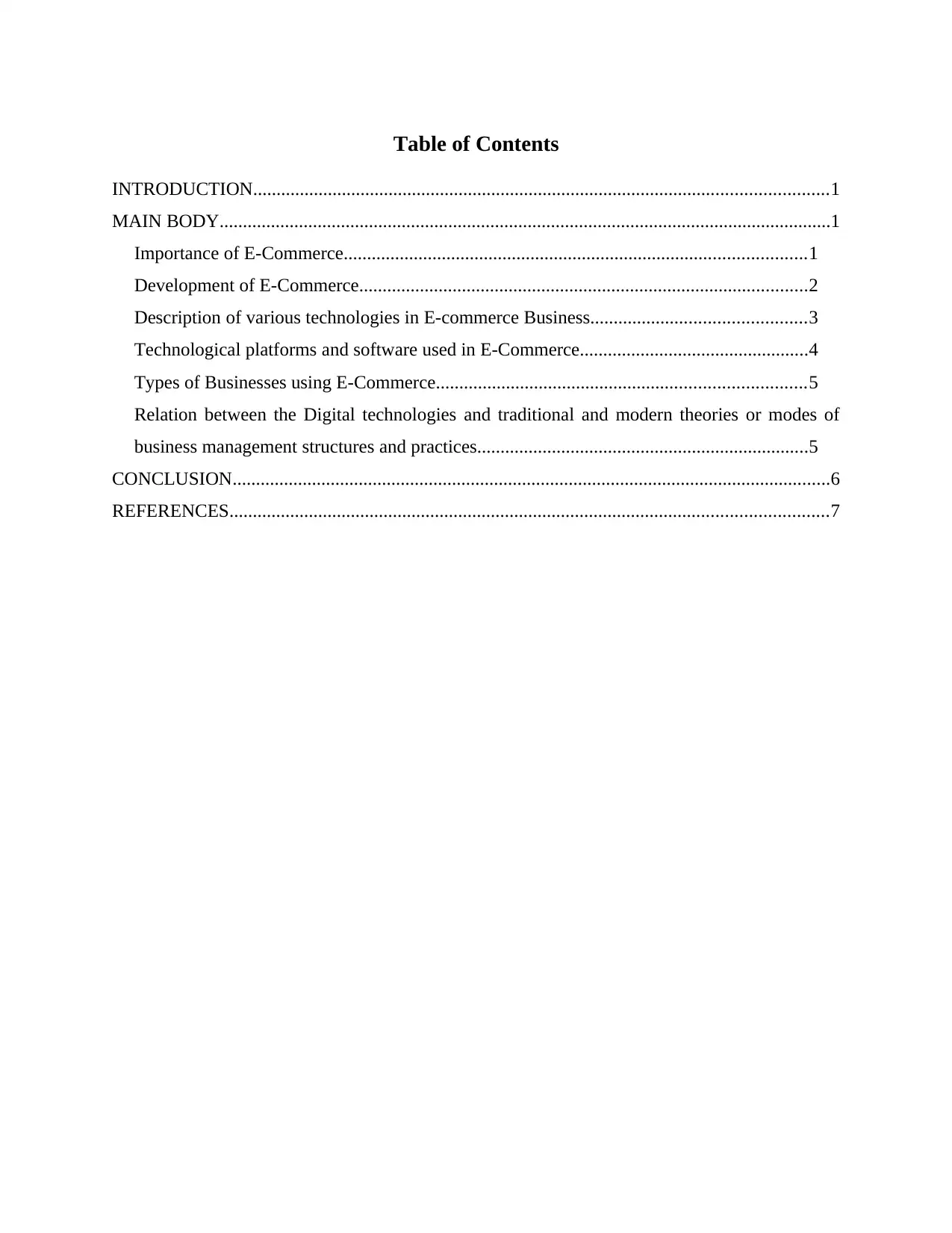
Table of Contents
INTRODUCTION...........................................................................................................................1
MAIN BODY...................................................................................................................................1
Importance of E-Commerce...................................................................................................1
Development of E-Commerce................................................................................................2
Description of various technologies in E-commerce Business..............................................3
Technological platforms and software used in E-Commerce.................................................4
Types of Businesses using E-Commerce...............................................................................5
Relation between the Digital technologies and traditional and modern theories or modes of
business management structures and practices.......................................................................5
CONCLUSION................................................................................................................................6
REFERENCES................................................................................................................................7
INTRODUCTION...........................................................................................................................1
MAIN BODY...................................................................................................................................1
Importance of E-Commerce...................................................................................................1
Development of E-Commerce................................................................................................2
Description of various technologies in E-commerce Business..............................................3
Technological platforms and software used in E-Commerce.................................................4
Types of Businesses using E-Commerce...............................................................................5
Relation between the Digital technologies and traditional and modern theories or modes of
business management structures and practices.......................................................................5
CONCLUSION................................................................................................................................6
REFERENCES................................................................................................................................7
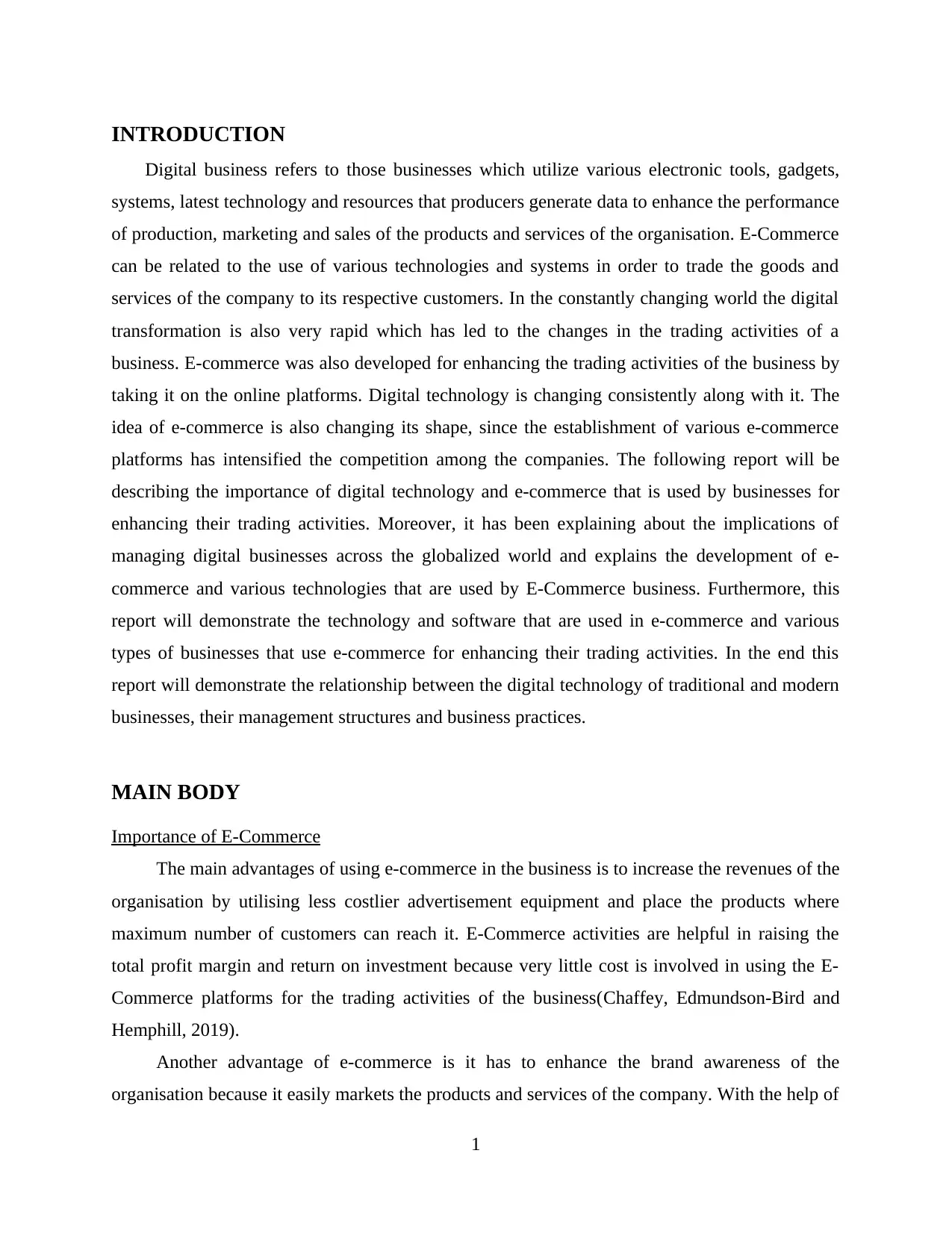
INTRODUCTION
Digital business refers to those businesses which utilize various electronic tools, gadgets,
systems, latest technology and resources that producers generate data to enhance the performance
of production, marketing and sales of the products and services of the organisation. E-Commerce
can be related to the use of various technologies and systems in order to trade the goods and
services of the company to its respective customers. In the constantly changing world the digital
transformation is also very rapid which has led to the changes in the trading activities of a
business. E-commerce was also developed for enhancing the trading activities of the business by
taking it on the online platforms. Digital technology is changing consistently along with it. The
idea of e-commerce is also changing its shape, since the establishment of various e-commerce
platforms has intensified the competition among the companies. The following report will be
describing the importance of digital technology and e-commerce that is used by businesses for
enhancing their trading activities. Moreover, it has been explaining about the implications of
managing digital businesses across the globalized world and explains the development of e-
commerce and various technologies that are used by E-Commerce business. Furthermore, this
report will demonstrate the technology and software that are used in e-commerce and various
types of businesses that use e-commerce for enhancing their trading activities. In the end this
report will demonstrate the relationship between the digital technology of traditional and modern
businesses, their management structures and business practices.
MAIN BODY
Importance of E-Commerce
The main advantages of using e-commerce in the business is to increase the revenues of the
organisation by utilising less costlier advertisement equipment and place the products where
maximum number of customers can reach it. E-Commerce activities are helpful in raising the
total profit margin and return on investment because very little cost is involved in using the E-
Commerce platforms for the trading activities of the business(Chaffey, Edmundson-Bird and
Hemphill, 2019).
Another advantage of e-commerce is it has to enhance the brand awareness of the
organisation because it easily markets the products and services of the company. With the help of
1
Digital business refers to those businesses which utilize various electronic tools, gadgets,
systems, latest technology and resources that producers generate data to enhance the performance
of production, marketing and sales of the products and services of the organisation. E-Commerce
can be related to the use of various technologies and systems in order to trade the goods and
services of the company to its respective customers. In the constantly changing world the digital
transformation is also very rapid which has led to the changes in the trading activities of a
business. E-commerce was also developed for enhancing the trading activities of the business by
taking it on the online platforms. Digital technology is changing consistently along with it. The
idea of e-commerce is also changing its shape, since the establishment of various e-commerce
platforms has intensified the competition among the companies. The following report will be
describing the importance of digital technology and e-commerce that is used by businesses for
enhancing their trading activities. Moreover, it has been explaining about the implications of
managing digital businesses across the globalized world and explains the development of e-
commerce and various technologies that are used by E-Commerce business. Furthermore, this
report will demonstrate the technology and software that are used in e-commerce and various
types of businesses that use e-commerce for enhancing their trading activities. In the end this
report will demonstrate the relationship between the digital technology of traditional and modern
businesses, their management structures and business practices.
MAIN BODY
Importance of E-Commerce
The main advantages of using e-commerce in the business is to increase the revenues of the
organisation by utilising less costlier advertisement equipment and place the products where
maximum number of customers can reach it. E-Commerce activities are helpful in raising the
total profit margin and return on investment because very little cost is involved in using the E-
Commerce platforms for the trading activities of the business(Chaffey, Edmundson-Bird and
Hemphill, 2019).
Another advantage of e-commerce is it has to enhance the brand awareness of the
organisation because it easily markets the products and services of the company. With the help of
1
⊘ This is a preview!⊘
Do you want full access?
Subscribe today to unlock all pages.

Trusted by 1+ million students worldwide
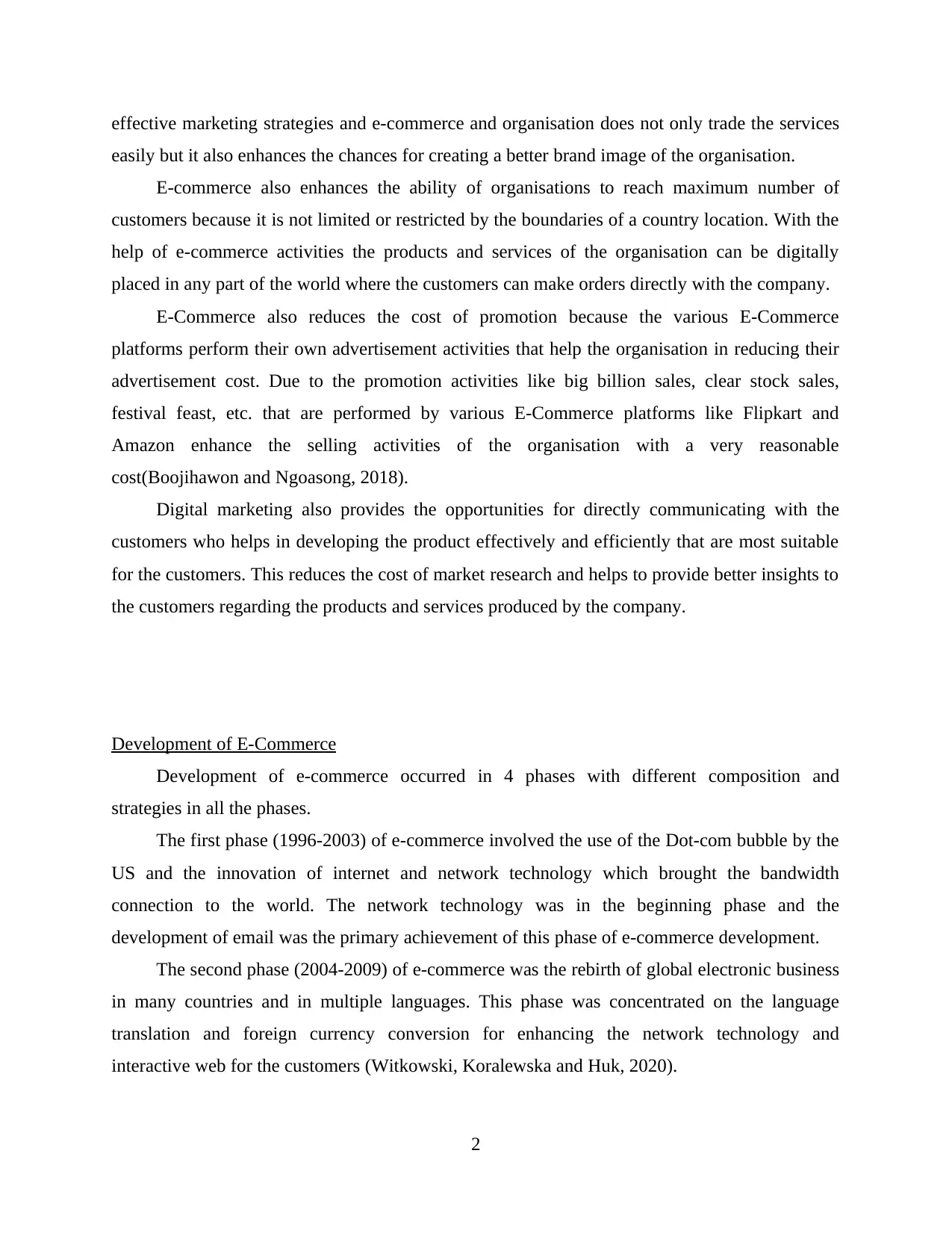
effective marketing strategies and e-commerce and organisation does not only trade the services
easily but it also enhances the chances for creating a better brand image of the organisation.
E-commerce also enhances the ability of organisations to reach maximum number of
customers because it is not limited or restricted by the boundaries of a country location. With the
help of e-commerce activities the products and services of the organisation can be digitally
placed in any part of the world where the customers can make orders directly with the company.
E-Commerce also reduces the cost of promotion because the various E-Commerce
platforms perform their own advertisement activities that help the organisation in reducing their
advertisement cost. Due to the promotion activities like big billion sales, clear stock sales,
festival feast, etc. that are performed by various E-Commerce platforms like Flipkart and
Amazon enhance the selling activities of the organisation with a very reasonable
cost(Boojihawon and Ngoasong, 2018).
Digital marketing also provides the opportunities for directly communicating with the
customers who helps in developing the product effectively and efficiently that are most suitable
for the customers. This reduces the cost of market research and helps to provide better insights to
the customers regarding the products and services produced by the company.
Development of E-Commerce
Development of e-commerce occurred in 4 phases with different composition and
strategies in all the phases.
The first phase (1996-2003) of e-commerce involved the use of the Dot-com bubble by the
US and the innovation of internet and network technology which brought the bandwidth
connection to the world. The network technology was in the beginning phase and the
development of email was the primary achievement of this phase of e-commerce development.
The second phase (2004-2009) of e-commerce was the rebirth of global electronic business
in many countries and in multiple languages. This phase was concentrated on the language
translation and foreign currency conversion for enhancing the network technology and
interactive web for the customers (Witkowski, Koralewska and Huk, 2020).
2
easily but it also enhances the chances for creating a better brand image of the organisation.
E-commerce also enhances the ability of organisations to reach maximum number of
customers because it is not limited or restricted by the boundaries of a country location. With the
help of e-commerce activities the products and services of the organisation can be digitally
placed in any part of the world where the customers can make orders directly with the company.
E-Commerce also reduces the cost of promotion because the various E-Commerce
platforms perform their own advertisement activities that help the organisation in reducing their
advertisement cost. Due to the promotion activities like big billion sales, clear stock sales,
festival feast, etc. that are performed by various E-Commerce platforms like Flipkart and
Amazon enhance the selling activities of the organisation with a very reasonable
cost(Boojihawon and Ngoasong, 2018).
Digital marketing also provides the opportunities for directly communicating with the
customers who helps in developing the product effectively and efficiently that are most suitable
for the customers. This reduces the cost of market research and helps to provide better insights to
the customers regarding the products and services produced by the company.
Development of E-Commerce
Development of e-commerce occurred in 4 phases with different composition and
strategies in all the phases.
The first phase (1996-2003) of e-commerce involved the use of the Dot-com bubble by the
US and the innovation of internet and network technology which brought the bandwidth
connection to the world. The network technology was in the beginning phase and the
development of email was the primary achievement of this phase of e-commerce development.
The second phase (2004-2009) of e-commerce was the rebirth of global electronic business
in many countries and in multiple languages. This phase was concentrated on the language
translation and foreign currency conversion for enhancing the network technology and
interactive web for the customers (Witkowski, Koralewska and Huk, 2020).
2
Paraphrase This Document
Need a fresh take? Get an instant paraphrase of this document with our AI Paraphraser
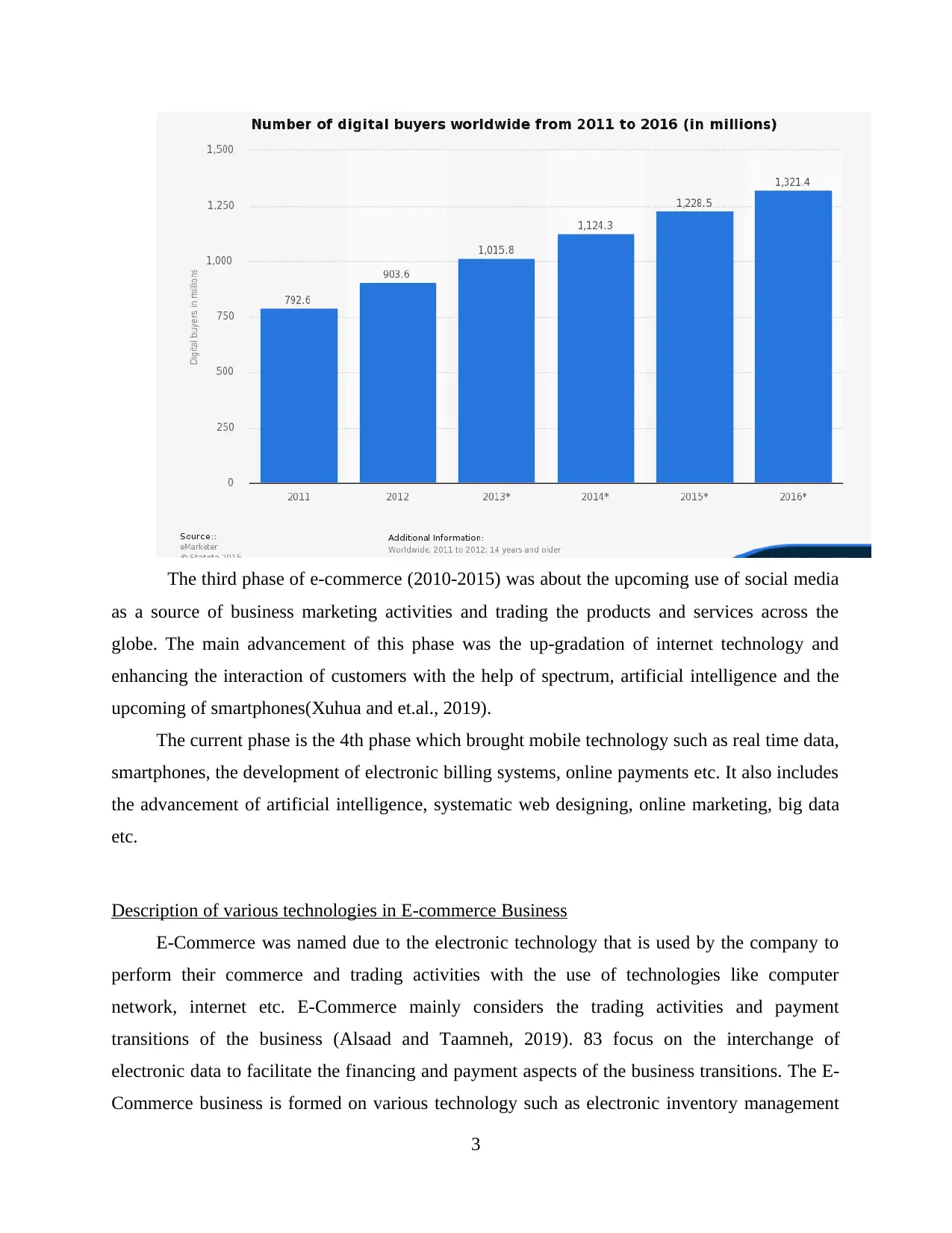
The third phase of e-commerce (2010-2015) was about the upcoming use of social media
as a source of business marketing activities and trading the products and services across the
globe. The main advancement of this phase was the up-gradation of internet technology and
enhancing the interaction of customers with the help of spectrum, artificial intelligence and the
upcoming of smartphones(Xuhua and et.al., 2019).
The current phase is the 4th phase which brought mobile technology such as real time data,
smartphones, the development of electronic billing systems, online payments etc. It also includes
the advancement of artificial intelligence, systematic web designing, online marketing, big data
etc.
Description of various technologies in E-commerce Business
E-Commerce was named due to the electronic technology that is used by the company to
perform their commerce and trading activities with the use of technologies like computer
network, internet etc. E-Commerce mainly considers the trading activities and payment
transitions of the business (Alsaad and Taamneh, 2019). 83 focus on the interchange of
electronic data to facilitate the financing and payment aspects of the business transitions. The E-
Commerce business is formed on various technology such as electronic inventory management
3
as a source of business marketing activities and trading the products and services across the
globe. The main advancement of this phase was the up-gradation of internet technology and
enhancing the interaction of customers with the help of spectrum, artificial intelligence and the
upcoming of smartphones(Xuhua and et.al., 2019).
The current phase is the 4th phase which brought mobile technology such as real time data,
smartphones, the development of electronic billing systems, online payments etc. It also includes
the advancement of artificial intelligence, systematic web designing, online marketing, big data
etc.
Description of various technologies in E-commerce Business
E-Commerce was named due to the electronic technology that is used by the company to
perform their commerce and trading activities with the use of technologies like computer
network, internet etc. E-Commerce mainly considers the trading activities and payment
transitions of the business (Alsaad and Taamneh, 2019). 83 focus on the interchange of
electronic data to facilitate the financing and payment aspects of the business transitions. The E-
Commerce business is formed on various technology such as electronic inventory management
3
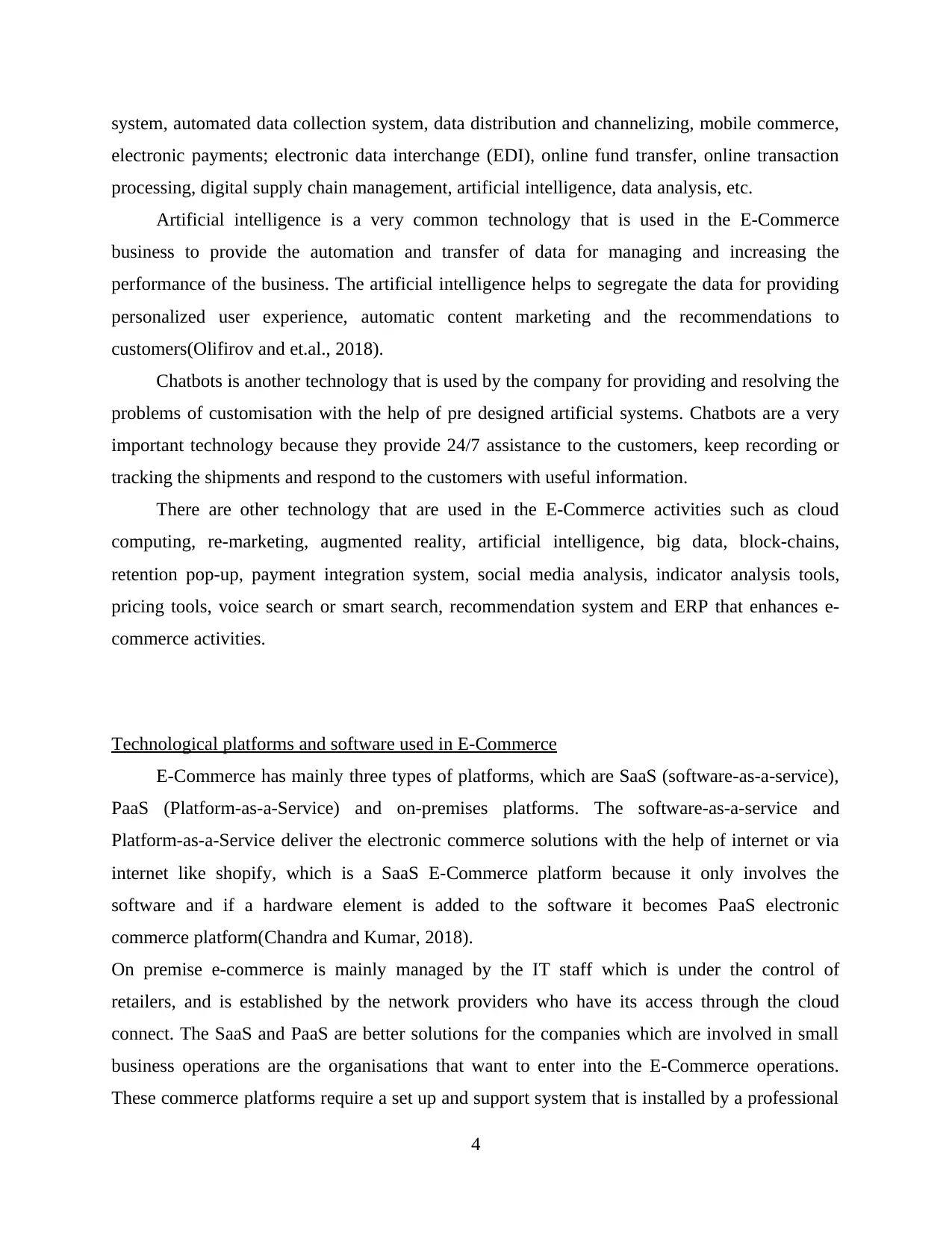
system, automated data collection system, data distribution and channelizing, mobile commerce,
electronic payments; electronic data interchange (EDI), online fund transfer, online transaction
processing, digital supply chain management, artificial intelligence, data analysis, etc.
Artificial intelligence is a very common technology that is used in the E-Commerce
business to provide the automation and transfer of data for managing and increasing the
performance of the business. The artificial intelligence helps to segregate the data for providing
personalized user experience, automatic content marketing and the recommendations to
customers(Olifirov and et.al., 2018).
Chatbots is another technology that is used by the company for providing and resolving the
problems of customisation with the help of pre designed artificial systems. Chatbots are a very
important technology because they provide 24/7 assistance to the customers, keep recording or
tracking the shipments and respond to the customers with useful information.
There are other technology that are used in the E-Commerce activities such as cloud
computing, re-marketing, augmented reality, artificial intelligence, big data, block-chains,
retention pop-up, payment integration system, social media analysis, indicator analysis tools,
pricing tools, voice search or smart search, recommendation system and ERP that enhances e-
commerce activities.
Technological platforms and software used in E-Commerce
E-Commerce has mainly three types of platforms, which are SaaS (software-as-a-service),
PaaS (Platform-as-a-Service) and on-premises platforms. The software-as-a-service and
Platform-as-a-Service deliver the electronic commerce solutions with the help of internet or via
internet like shopify, which is a SaaS E-Commerce platform because it only involves the
software and if a hardware element is added to the software it becomes PaaS electronic
commerce platform(Chandra and Kumar, 2018).
On premise e-commerce is mainly managed by the IT staff which is under the control of
retailers, and is established by the network providers who have its access through the cloud
connect. The SaaS and PaaS are better solutions for the companies which are involved in small
business operations are the organisations that want to enter into the E-Commerce operations.
These commerce platforms require a set up and support system that is installed by a professional
4
electronic payments; electronic data interchange (EDI), online fund transfer, online transaction
processing, digital supply chain management, artificial intelligence, data analysis, etc.
Artificial intelligence is a very common technology that is used in the E-Commerce
business to provide the automation and transfer of data for managing and increasing the
performance of the business. The artificial intelligence helps to segregate the data for providing
personalized user experience, automatic content marketing and the recommendations to
customers(Olifirov and et.al., 2018).
Chatbots is another technology that is used by the company for providing and resolving the
problems of customisation with the help of pre designed artificial systems. Chatbots are a very
important technology because they provide 24/7 assistance to the customers, keep recording or
tracking the shipments and respond to the customers with useful information.
There are other technology that are used in the E-Commerce activities such as cloud
computing, re-marketing, augmented reality, artificial intelligence, big data, block-chains,
retention pop-up, payment integration system, social media analysis, indicator analysis tools,
pricing tools, voice search or smart search, recommendation system and ERP that enhances e-
commerce activities.
Technological platforms and software used in E-Commerce
E-Commerce has mainly three types of platforms, which are SaaS (software-as-a-service),
PaaS (Platform-as-a-Service) and on-premises platforms. The software-as-a-service and
Platform-as-a-Service deliver the electronic commerce solutions with the help of internet or via
internet like shopify, which is a SaaS E-Commerce platform because it only involves the
software and if a hardware element is added to the software it becomes PaaS electronic
commerce platform(Chandra and Kumar, 2018).
On premise e-commerce is mainly managed by the IT staff which is under the control of
retailers, and is established by the network providers who have its access through the cloud
connect. The SaaS and PaaS are better solutions for the companies which are involved in small
business operations are the organisations that want to enter into the E-Commerce operations.
These commerce platforms require a set up and support system that is installed by a professional
4
⊘ This is a preview!⊘
Do you want full access?
Subscribe today to unlock all pages.

Trusted by 1+ million students worldwide
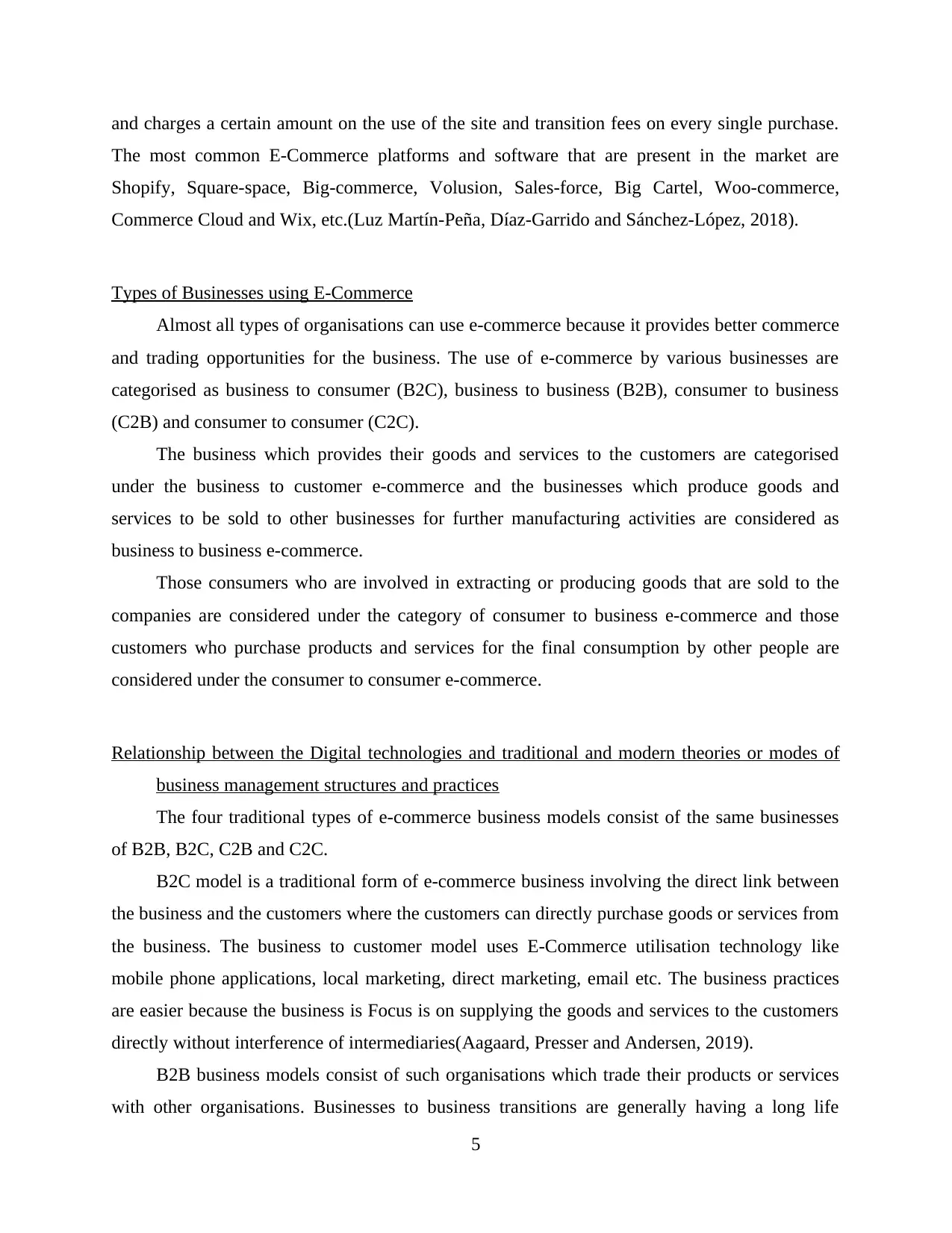
and charges a certain amount on the use of the site and transition fees on every single purchase.
The most common E-Commerce platforms and software that are present in the market are
Shopify, Square-space, Big-commerce, Volusion, Sales-force, Big Cartel, Woo-commerce,
Commerce Cloud and Wix, etc.(Luz Martín‐Peña, Díaz‐Garrido and Sánchez‐López, 2018).
Types of Businesses using E-Commerce
Almost all types of organisations can use e-commerce because it provides better commerce
and trading opportunities for the business. The use of e-commerce by various businesses are
categorised as business to consumer (B2C), business to business (B2B), consumer to business
(C2B) and consumer to consumer (C2C).
The business which provides their goods and services to the customers are categorised
under the business to customer e-commerce and the businesses which produce goods and
services to be sold to other businesses for further manufacturing activities are considered as
business to business e-commerce.
Those consumers who are involved in extracting or producing goods that are sold to the
companies are considered under the category of consumer to business e-commerce and those
customers who purchase products and services for the final consumption by other people are
considered under the consumer to consumer e-commerce.
Relationship between the Digital technologies and traditional and modern theories or modes of
business management structures and practices
The four traditional types of e-commerce business models consist of the same businesses
of B2B, B2C, C2B and C2C.
B2C model is a traditional form of e-commerce business involving the direct link between
the business and the customers where the customers can directly purchase goods or services from
the business. The business to customer model uses E-Commerce utilisation technology like
mobile phone applications, local marketing, direct marketing, email etc. The business practices
are easier because the business is Focus is on supplying the goods and services to the customers
directly without interference of intermediaries(Aagaard, Presser and Andersen, 2019).
B2B business models consist of such organisations which trade their products or services
with other organisations. Businesses to business transitions are generally having a long life
5
The most common E-Commerce platforms and software that are present in the market are
Shopify, Square-space, Big-commerce, Volusion, Sales-force, Big Cartel, Woo-commerce,
Commerce Cloud and Wix, etc.(Luz Martín‐Peña, Díaz‐Garrido and Sánchez‐López, 2018).
Types of Businesses using E-Commerce
Almost all types of organisations can use e-commerce because it provides better commerce
and trading opportunities for the business. The use of e-commerce by various businesses are
categorised as business to consumer (B2C), business to business (B2B), consumer to business
(C2B) and consumer to consumer (C2C).
The business which provides their goods and services to the customers are categorised
under the business to customer e-commerce and the businesses which produce goods and
services to be sold to other businesses for further manufacturing activities are considered as
business to business e-commerce.
Those consumers who are involved in extracting or producing goods that are sold to the
companies are considered under the category of consumer to business e-commerce and those
customers who purchase products and services for the final consumption by other people are
considered under the consumer to consumer e-commerce.
Relationship between the Digital technologies and traditional and modern theories or modes of
business management structures and practices
The four traditional types of e-commerce business models consist of the same businesses
of B2B, B2C, C2B and C2C.
B2C model is a traditional form of e-commerce business involving the direct link between
the business and the customers where the customers can directly purchase goods or services from
the business. The business to customer model uses E-Commerce utilisation technology like
mobile phone applications, local marketing, direct marketing, email etc. The business practices
are easier because the business is Focus is on supplying the goods and services to the customers
directly without interference of intermediaries(Aagaard, Presser and Andersen, 2019).
B2B business models consist of such organisations which trade their products or services
with other organisations. Businesses to business transitions are generally having a long life
5
Paraphrase This Document
Need a fresh take? Get an instant paraphrase of this document with our AI Paraphraser
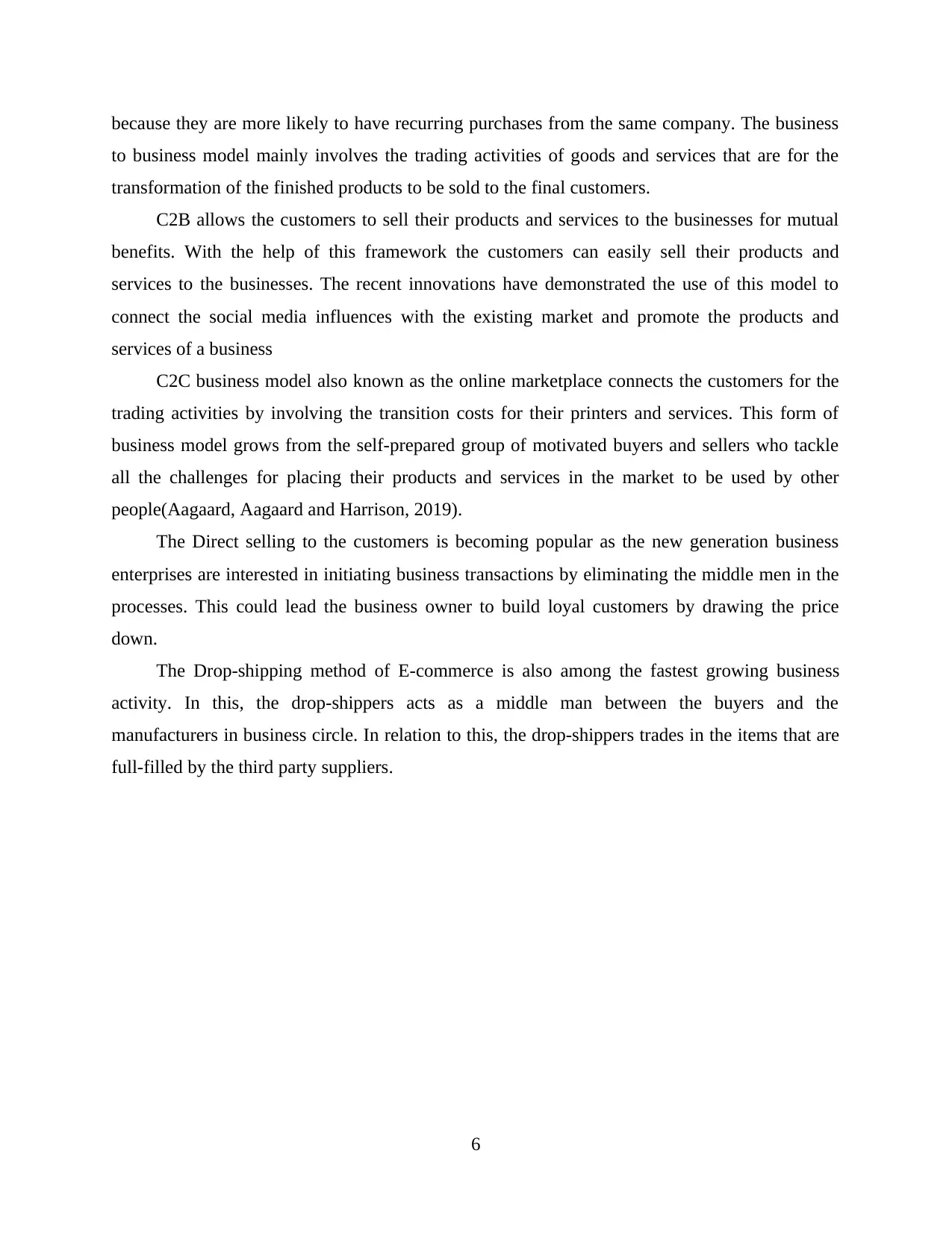
because they are more likely to have recurring purchases from the same company. The business
to business model mainly involves the trading activities of goods and services that are for the
transformation of the finished products to be sold to the final customers.
C2B allows the customers to sell their products and services to the businesses for mutual
benefits. With the help of this framework the customers can easily sell their products and
services to the businesses. The recent innovations have demonstrated the use of this model to
connect the social media influences with the existing market and promote the products and
services of a business
C2C business model also known as the online marketplace connects the customers for the
trading activities by involving the transition costs for their printers and services. This form of
business model grows from the self-prepared group of motivated buyers and sellers who tackle
all the challenges for placing their products and services in the market to be used by other
people(Aagaard, Aagaard and Harrison, 2019).
The Direct selling to the customers is becoming popular as the new generation business
enterprises are interested in initiating business transactions by eliminating the middle men in the
processes. This could lead the business owner to build loyal customers by drawing the price
down.
The Drop-shipping method of E-commerce is also among the fastest growing business
activity. In this, the drop-shippers acts as a middle man between the buyers and the
manufacturers in business circle. In relation to this, the drop-shippers trades in the items that are
full-filled by the third party suppliers.
6
to business model mainly involves the trading activities of goods and services that are for the
transformation of the finished products to be sold to the final customers.
C2B allows the customers to sell their products and services to the businesses for mutual
benefits. With the help of this framework the customers can easily sell their products and
services to the businesses. The recent innovations have demonstrated the use of this model to
connect the social media influences with the existing market and promote the products and
services of a business
C2C business model also known as the online marketplace connects the customers for the
trading activities by involving the transition costs for their printers and services. This form of
business model grows from the self-prepared group of motivated buyers and sellers who tackle
all the challenges for placing their products and services in the market to be used by other
people(Aagaard, Aagaard and Harrison, 2019).
The Direct selling to the customers is becoming popular as the new generation business
enterprises are interested in initiating business transactions by eliminating the middle men in the
processes. This could lead the business owner to build loyal customers by drawing the price
down.
The Drop-shipping method of E-commerce is also among the fastest growing business
activity. In this, the drop-shippers acts as a middle man between the buyers and the
manufacturers in business circle. In relation to this, the drop-shippers trades in the items that are
full-filled by the third party suppliers.
6

CONCLUSION
It has been analysed from the above report that digital technology is very crucial for
business organisation in order to boost the efficiency level of systems, services as well as product
of the company. It has also analysed from the above that digital technologies has allowed the
business enterprise to monitor and streamline their business processes. It was also evaluated that
digital technologies assisted the firm reducing their operational costs to the great extent and also
helped the businesses to grow more rapidly in the competitive environment. The report was able
to explain about the importance of business technologies as well as also explained about the
technological software's usage in improving efficiency of business operations and processes. In
addition to this, the report has also explained about the relationship between digital marketing as
well as traditional theories of business management.
7
It has been analysed from the above report that digital technology is very crucial for
business organisation in order to boost the efficiency level of systems, services as well as product
of the company. It has also analysed from the above that digital technologies has allowed the
business enterprise to monitor and streamline their business processes. It was also evaluated that
digital technologies assisted the firm reducing their operational costs to the great extent and also
helped the businesses to grow more rapidly in the competitive environment. The report was able
to explain about the importance of business technologies as well as also explained about the
technological software's usage in improving efficiency of business operations and processes. In
addition to this, the report has also explained about the relationship between digital marketing as
well as traditional theories of business management.
7
⊘ This is a preview!⊘
Do you want full access?
Subscribe today to unlock all pages.

Trusted by 1+ million students worldwide
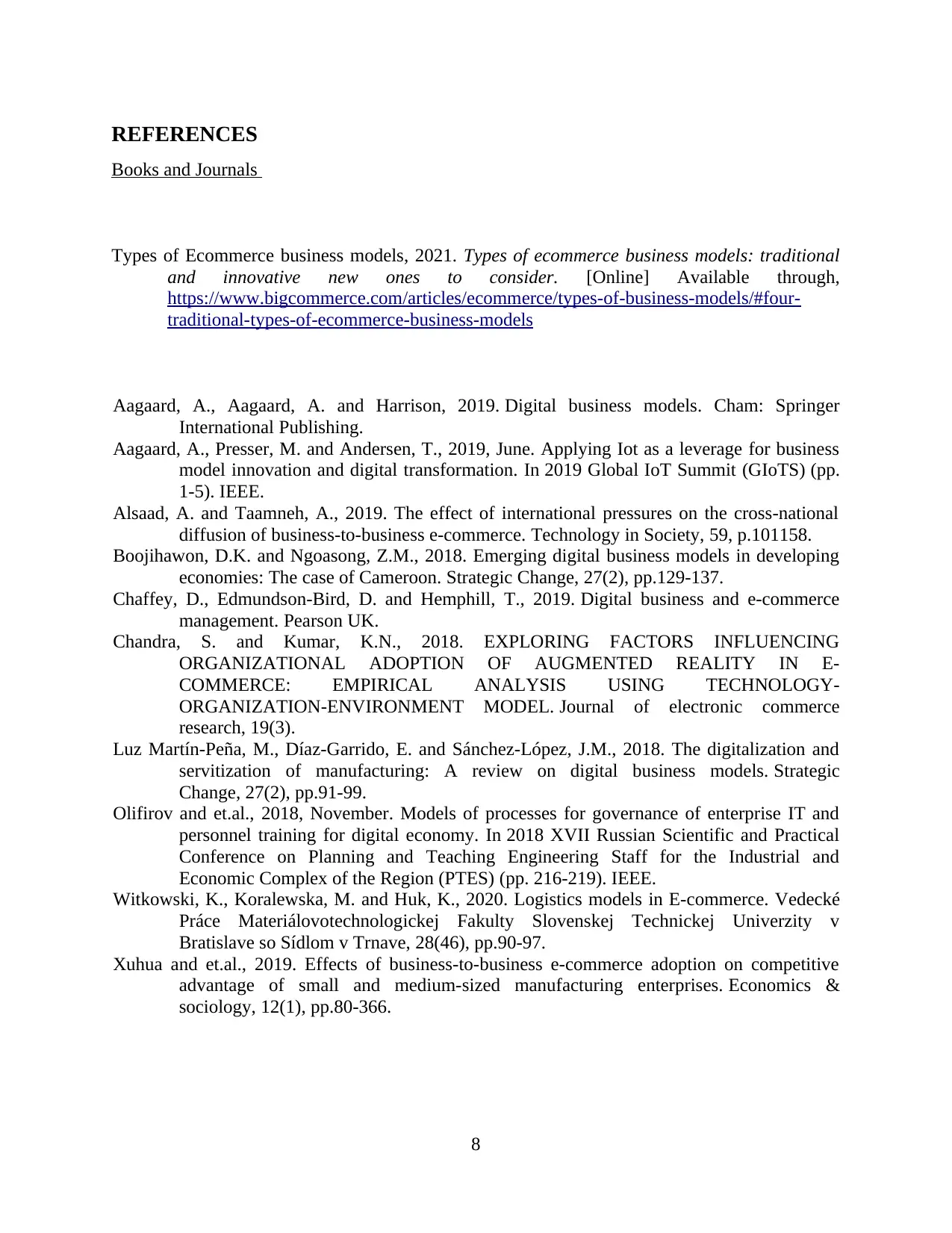
REFERENCES
Books and Journals
Types of Ecommerce business models, 2021. Types of ecommerce business models: traditional
and innovative new ones to consider. [Online] Available through,
https://www.bigcommerce.com/articles/ecommerce/types-of-business-models/#four-
traditional-types-of-ecommerce-business-models
Aagaard, A., Aagaard, A. and Harrison, 2019. Digital business models. Cham: Springer
International Publishing.
Aagaard, A., Presser, M. and Andersen, T., 2019, June. Applying Iot as a leverage for business
model innovation and digital transformation. In 2019 Global IoT Summit (GIoTS) (pp.
1-5). IEEE.
Alsaad, A. and Taamneh, A., 2019. The effect of international pressures on the cross-national
diffusion of business-to-business e-commerce. Technology in Society, 59, p.101158.
Boojihawon, D.K. and Ngoasong, Z.M., 2018. Emerging digital business models in developing
economies: The case of Cameroon. Strategic Change, 27(2), pp.129-137.
Chaffey, D., Edmundson-Bird, D. and Hemphill, T., 2019. Digital business and e-commerce
management. Pearson UK.
Chandra, S. and Kumar, K.N., 2018. EXPLORING FACTORS INFLUENCING
ORGANIZATIONAL ADOPTION OF AUGMENTED REALITY IN E-
COMMERCE: EMPIRICAL ANALYSIS USING TECHNOLOGY-
ORGANIZATION-ENVIRONMENT MODEL. Journal of electronic commerce
research, 19(3).
Luz Martín‐Peña, M., Díaz‐Garrido, E. and Sánchez‐López, J.M., 2018. The digitalization and
servitization of manufacturing: A review on digital business models. Strategic
Change, 27(2), pp.91-99.
Olifirov and et.al., 2018, November. Models of processes for governance of enterprise IT and
personnel training for digital economy. In 2018 XVII Russian Scientific and Practical
Conference on Planning and Teaching Engineering Staff for the Industrial and
Economic Complex of the Region (PTES) (pp. 216-219). IEEE.
Witkowski, K., Koralewska, M. and Huk, K., 2020. Logistics models in E-commerce. Vedecké
Práce Materiálovotechnologickej Fakulty Slovenskej Technickej Univerzity v
Bratislave so Sídlom v Trnave, 28(46), pp.90-97.
Xuhua and et.al., 2019. Effects of business-to-business e-commerce adoption on competitive
advantage of small and medium-sized manufacturing enterprises. Economics &
sociology, 12(1), pp.80-366.
8
Books and Journals
Types of Ecommerce business models, 2021. Types of ecommerce business models: traditional
and innovative new ones to consider. [Online] Available through,
https://www.bigcommerce.com/articles/ecommerce/types-of-business-models/#four-
traditional-types-of-ecommerce-business-models
Aagaard, A., Aagaard, A. and Harrison, 2019. Digital business models. Cham: Springer
International Publishing.
Aagaard, A., Presser, M. and Andersen, T., 2019, June. Applying Iot as a leverage for business
model innovation and digital transformation. In 2019 Global IoT Summit (GIoTS) (pp.
1-5). IEEE.
Alsaad, A. and Taamneh, A., 2019. The effect of international pressures on the cross-national
diffusion of business-to-business e-commerce. Technology in Society, 59, p.101158.
Boojihawon, D.K. and Ngoasong, Z.M., 2018. Emerging digital business models in developing
economies: The case of Cameroon. Strategic Change, 27(2), pp.129-137.
Chaffey, D., Edmundson-Bird, D. and Hemphill, T., 2019. Digital business and e-commerce
management. Pearson UK.
Chandra, S. and Kumar, K.N., 2018. EXPLORING FACTORS INFLUENCING
ORGANIZATIONAL ADOPTION OF AUGMENTED REALITY IN E-
COMMERCE: EMPIRICAL ANALYSIS USING TECHNOLOGY-
ORGANIZATION-ENVIRONMENT MODEL. Journal of electronic commerce
research, 19(3).
Luz Martín‐Peña, M., Díaz‐Garrido, E. and Sánchez‐López, J.M., 2018. The digitalization and
servitization of manufacturing: A review on digital business models. Strategic
Change, 27(2), pp.91-99.
Olifirov and et.al., 2018, November. Models of processes for governance of enterprise IT and
personnel training for digital economy. In 2018 XVII Russian Scientific and Practical
Conference on Planning and Teaching Engineering Staff for the Industrial and
Economic Complex of the Region (PTES) (pp. 216-219). IEEE.
Witkowski, K., Koralewska, M. and Huk, K., 2020. Logistics models in E-commerce. Vedecké
Práce Materiálovotechnologickej Fakulty Slovenskej Technickej Univerzity v
Bratislave so Sídlom v Trnave, 28(46), pp.90-97.
Xuhua and et.al., 2019. Effects of business-to-business e-commerce adoption on competitive
advantage of small and medium-sized manufacturing enterprises. Economics &
sociology, 12(1), pp.80-366.
8
Paraphrase This Document
Need a fresh take? Get an instant paraphrase of this document with our AI Paraphraser

9
1 out of 11
Related Documents
Your All-in-One AI-Powered Toolkit for Academic Success.
+13062052269
info@desklib.com
Available 24*7 on WhatsApp / Email
![[object Object]](/_next/static/media/star-bottom.7253800d.svg)
Unlock your academic potential
Copyright © 2020–2025 A2Z Services. All Rights Reserved. Developed and managed by ZUCOL.



